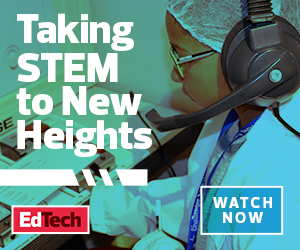This is just one example of how technology can give students who think and learn differently a more personalized and accessible learning experience.
Referred to as assistive technology, these tools are “any type of equipment or software that helps people to work around the challenges they have, whether that be with learning, communication or mobility,” explains Kara Ball, an elementary science and STEM education specialist for Baltimore City Public Schools and a special education expert at Understood, a nonprofit organization providing support for people with disabilities and their families.
But what types of assistive technology tools are out there? And how can educators best use them in a modern learning environment to help students of all abilities reach their full potential?
MORE ON EDTECH: Read about the 2020 ed tech trends that focus on equity and tech accessibility.
Examples of Assistive Technology in the Classroom
Nearly 7 million students in the U.S. — almost 14 percent of all students — received special education in the 2017–2018 school year under the Individuals with Disabilities Education Act (IDEA), according to the most recent figures from the U.S. Department of Education.
To ensure those services are provided and that instruction is inclusive of all learners, school districts are increasingly integrating assistive technology tools in general education classrooms.
Ball categorizes them into two areas: high tech and low tech. High tech refers to devices or equipment with digital or electronic components, such as augmentative communication devices, alternative keyboards and power wheelchairs. It also includes software or built-in accessibility features on devices such as text to speech, word prediction and optical character recognition. Low tech refers to simple adaptive tools such as timers, graphic organizers and flexible furniture.
“Assistive technology really gives students the ability to access grade-level content and allows them to be independent,” Ball says.
Adopting Assistive Technology in a Modern Learning Environment
As schools increasingly embrace modern learning environments and integrate technology into classrooms and the curriculum, they must also be mindful about potential barriers of technology in special education.
Here are a few ways educators can use digital tools in the classroom to meet the individual needs of their students and help them through learning challenges:
- For students who are blind or visually impaired: Today, many devices such as Google Chromebooks come with audiovisual assistance. For example, Chromebooks have a built-in screen reader called ChromeVox, which reads content out loud for users on the Chrome browser. Chromebooks also have features that make on-screen content easier to read, such as screen magnifiers, high-contrast mode and select-to-speak. Teachers can also plug in or pair a Braille keyboard with Bluetooth if students need Braille support. Popular cloud-based applications such as G Suite for Education and Microsoft Office 365 also have dictation capabilities, allowing students to type by using their voice.
- For students who are deaf or hard of hearing: Ball says she uses FM systems — wireless devices that directly transmit sounds to a hearing aid — to communicate clearly with students who have hearing loss, even in a noisy classroom. For teachers using video technology in the classroom, there are educational apps such as Flipgrid with closed-caption features, as well as videoconferencing tools such as Microsoft Teams, which comes with live captioning and subtitles.
- For students with speech disabilities: Speech-to-text software and word prediction tools can assist students with speech disabilities in communicating with their teachers and peers. For example, Office 365 applications have Dictate, an AI-enabled add-in that allows students to speak into a microphone and have their speech converted into text on the computer.
- For students with learning, cognitive and developmental disabilities: Besides creating VR experiences for students with autism, tools such as memory aids, audio books and text-to-speech systems are especially helpful for students who need assistance with learning, attention and organization. One particular tool is Microsoft’s Immersive Reader, which was specifically designed to support students with dyslexia and dysgraphia. With the Immersive Reader, students can have text read out loud and broken into syllables — even in other languages. Microsoft’s Tell Me feature allows students to access commands on Office 365 applications without having to remember them. There are also downloadable fonts such as OpenDyslexic, which can enhance readability and reading speed for students with dyslexia, Ball says. Plus, there are handy smart tools such as the Livescribe Echo Smartpen, which acts as an all-in-one microphone, speaker and storage device.
- For students who need mobility assistance: One way teachers can optimize their classrooms for all students is by adopting flexible furniture, a key component of a modern learning environment. Standing desks, wobble stools and even exercise balls give students more freedom and comfort to move around in the classroom, Ball says. Another example is having students use interactive displays or touch-screen monitors if they aren’t physically able to use a keyboard or computer mouse.
With assistive technology, schools can create more inclusive classrooms and empower students with disabilities to participate in the general education curriculum.
“If I’d had any of those options available to me, I probably would have been a very different student,” says Ball, who has dyslexia and dyscalcula. “Being able to give students these resources to help them be independent is really the benefit of these technologies.”











